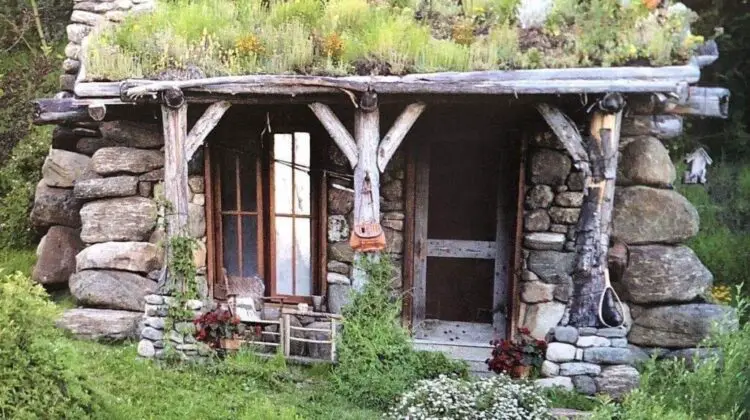Building an Off-Grid Log Cabin Tiny House: A Step-by-Step Guide Using Free Natural Materials
If you’ve ever dreamed of creating a self-sustaining haven in the wilderness, building an off-grid log cabin tiny house using only hand tools and free natural materials could be your ultimate project. In this guide, we’ll take you through the entire process of constructing a cozy log cabin, using cedar wood, stones, and other resources sourced directly from nature. This step-by-step approach not only aligns with eco-friendly practices but also offers a rewarding and immersive experience in craftsmanship.

Step 1: Planning and Design
Before you start construction, it’s crucial to plan and design your off-grid log cabin tiny house. Begin by selecting a suitable location in your woodland, taking into consideration factors such as sunlight, drainage, and proximity to natural resources. Sketch out a basic floor plan, including the dimensions, layout, and key features you want in your cabin.
Step 2: Sourcing Natural Materials
For this project, we utilized cedar wood, which is abundant in many woodlands and offers excellent durability and resistance to insects. Cedar is also relatively easy to work with using hand tools. Along with cedar, we gathered stones from the surrounding area for foundational support and aesthetic purposes. Additionally, collect other natural materials such as moss for insulation and branches for smaller structural elements.

Step 3: Preparing the Site
Clear the area where you plan to build your log cabin. Remove any debris, trees, and underbrush to create a level surface. It’s essential to prepare the site thoroughly to ensure stability and proper drainage for your cabin. You may also need to dig a trench for the foundation, especially if you’re using stones.
Step 4: Building the Foundation
Start by laying a stone foundation to provide a solid base for your cabin. Arrange the stones in a stable configuration, ensuring they are level and secure. This step is crucial for preventing moisture from seeping into the cabin and for providing a sturdy base for the log walls.

Step 5: Constructing the Log Walls
With the foundation in place, you can begin constructing the log walls of your cabin. Select cedar logs of similar diameter and length. Notch the logs at the ends to fit snugly with the adjoining logs, creating a secure and insulated wall structure. Use hand tools such as a saw, axe, and chisel to shape the logs and create precise notches.
Step 6: Assembling the Cabin
Once the logs are prepared, stack them on top of the foundation, aligning the notched ends to form a continuous wall. Secure the logs in place using wooden pegs or dowels, and fill any gaps with moss or other natural insulation materials. Continue this process until you have completed the walls and the cabin is at your desired height.

Step 7: Adding the Roof
For the roof, use additional cedar logs or branches to create a sturdy framework. Cover the framework with overlapping layers of cedar shingles or other natural materials to ensure a waterproof and insulated roof. Secure the shingles with wooden nails or pegs, and make sure the roof has a slight pitch to allow for proper water runoff.
Step 8: Installing Doors and Windows
Craft doors and windows from cedar wood, ensuring they fit snugly within the wall openings. Use hinges and latches that can be crafted from metal or wood, depending on what you have available. Seal the gaps around the doors and windows with natural materials like moss or clay to keep the cabin insulated.

Step 9: Interior Finishing Touches
Inside your log cabin, use cedar wood for flooring and furniture. Create built-in shelves, a bed, and storage spaces to maximize the small area. Decorate the interior with natural materials such as woven mats, handmade curtains, and rustic furnishings to give your cabin a cozy and inviting atmosphere.
Step 10: Off-Grid Utilities
Since your cabin is off-grid, consider incorporating sustainable energy sources such as solar panels or a small wind turbine for electricity. Set up a rainwater collection system and build a composting toilet to manage waste. Ensure that your off-grid solutions are efficient and eco-friendly to complement your self-sufficient lifestyle.

Conclusion
Building an off-grid log cabin tiny house using free natural materials and hand tools is a fulfilling and sustainable project. By following these steps—from sourcing materials and constructing the foundation to finishing the interior—you can create a charming and functional retreat in the wilderness. This approach not only respects the environment but also offers a unique connection to nature and traditional craftsmanship.
Whether you’re looking for a peaceful homestead or a rustic getaway, constructing a log cabin with cedar wood, stones, and other natural resources is a rewarding endeavor that results in a beautiful and self-sufficient home.
By focusing on using free natural materials and traditional hand tools, you can build an eco-friendly log cabin that stands the test of time. Embrace this journey and enjoy the satisfaction of creating your very own off-grid sanctuary.



